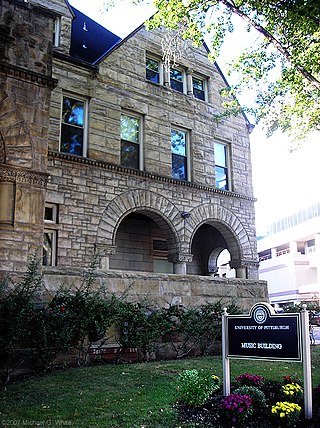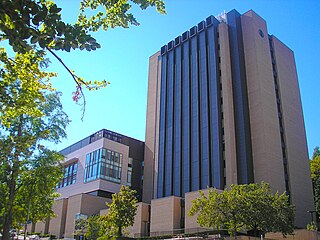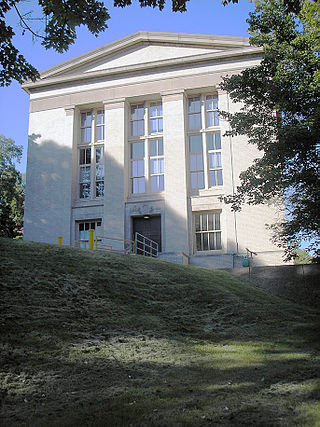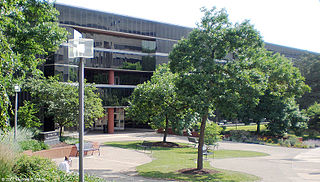
Wesley W. Posvar Hall (WWPH), formerly known as Forbes Quadrangle, is a landmark building on the campus of the University of Pittsburgh in Pittsburgh, Pennsylvania, United States. At 744,695 square feet (69,184.4 m2) it is the largest academic-use building on campus, providing administrative offices, classrooms, lecture halls, a food court, and computer labs. The hall sits on the former site of Forbes Field and contains several artifacts, including the former stadium's home plate and one of two surviving Langley Aerodromes.

Hillman Library is the largest library and the center of administration for the University Library System (ULS) of the University of Pittsburgh in Pittsburgh, Pennsylvania, United States. Located on the corner of Forbes Avenue and Schenley Drive, diagonally across from the Cathedral of Learning, Hillman serves as the flagship of the approximately 7.1 million-volume University Library System at Pitt.

The Clapp-Langley-Crawford halls complex, comprises three inter-connected buildings and the Life Science Annex that house the Department of Biological Science and the Department of Neuroscience at the University of Pittsburgh in Pittsburgh, Pennsylvania, United States.

The Music Building is an academic building of the University of Pittsburgh in Pittsburgh, Pennsylvania, United States, and a contributing property to the Schenley Farms National Historic District. A Longfellow, Alden & Harlow-designed mansion that was originally the home of the pastor of a neighboring church and former university chancellor, it also served as the home to a local chapter of the Knights of Columbus, as chemical laboratories, and as the first home of educational television station WQED and that station's original production site for Mister Rogers' Neighborhood. Today it is home to the University of Pittsburgh's Department of Music and the school's Theodore M. Finney Music Library.

Old Engineering Hall is an academic building at 3943 O'Hara Street on the campus of the University of Pittsburgh in Pittsburgh, Pennsylvania, United States. The building was completed for $1.2 million($13.6 million today) in October, 1955. The seven floor building connects Allen Hall and Thaw Hall, as well as the Van de Graaff Building which was added later. The frieze around the top of the building includes bas-relief of the insignia of several engineering societies. Originally called Engineering Hall, it initially contained engineering offices, classrooms, laboratories, a library, and in the basement, a wind tunnel for the aeronautical engineering department testing of airfoil surfaces.

Chevron Science Center is a landmark academic building at 219 Parkman Avenue in Pittsburgh, Pennsylvania, United States on the campus of the University of Pittsburgh. The 15-story facility, completed in 1974, was designed by Kuhn, Newcomer & Valentour and houses the university's chemistry department. A three-story addition above Ashe Auditorium was completed in 2011.

Thaw Hall is a historic academic building on the campus of the University of Pittsburgh that is a contributing property to the Schenley Farms National Historic District and has been named a Pittsburgh History and Landmarks Foundation Historic Landmark. The five-story building of stone, brick, and terra cotta was completed in 1910 in the Neoclassical Beaux-Arts style by architect Henry Hornbostel and today serves as space for a variety of academic classrooms, labs, offices, and centers. It is located between, and connected to, the university's Old Engineering Hall and Space Research Coordination Center (SRCC) along O'Hara Street in the Oakland neighborhood of Pittsburgh.

Eberly Hall is an academic building on the campus of the University of Pittsburgh in Pittsburgh, Pennsylvania, United States. Designed by architect Benno Janssen and dedicated in 1921, Eberly Hall was originally named Alumni Hall, and is still sometimes referred to as "Old Alumni Hall".

George Hubbard Clapp Hall is a contributing property to the Schenley Farms National Historic District on the campus of the University of Pittsburgh in the Oakland section of Pittsburgh, Pennsylvania. The six-story Gothic Revival structure, designed by Trautwein & Howard, was completed in 1956 and serves as the primary facility of the University of Pittsburgh Department of Biological Sciences. It contains laboratories, classrooms, a greenhouse, and an amphitheater-style lecture hall with 404 seats.

Michael L. Benedum Hall of Engineering is a landmark academic building on the campus of the University of Pittsburgh in Pittsburgh, Pennsylvania, United States. The building was designed in the brutalist style by the architectural firm of Deeter, Ritchey, and Sippel and completed in 1971 at a cost of $15 million. The building was honored with both the Pennsylvania Society American Institute of Architects Honor Award and Distinguished Building Award. It was built with a gift from the Claude Worthington Benedum Foundation and funds from the General State Authority. It stands on a 1.8-acre (7,300 m2) site that was formerly occupied by the National Guard's Logan Armory.

Barco Law Building is an academic building housing the University of Pittsburgh School of Law on the campus of the University of Pittsburgh in Pittsburgh, Pennsylvania, United States. The $8.5 million six-story building was opened in January 1976 and dedicated on May 1, 1976. The Barco Law Building was designed by the architectural firm of Johnstone, Newcomer and Valentour and is a classic example of brutalist architecture.

David Lawrence Hall is a major academic building at the University of Pittsburgh in Pittsburgh, Pennsylvania, United States, where it serves as the school's largest lecture hall and auditorium facility.

The upper campus residence halls at the University of Pittsburgh include Sutherland Hall, Panther Hall, K. Leroy Irvis Hall, the fraternity housing complex, and the Darragh Street Apartments. Among the newest residence facilities at the university, these buildings reside on the upper campus located near many of the school's athletic facilities. The upper campus resides approximately 200 feet (61 m) above the lower campus that lies along Forbes and Fifth Avenues, providing dramatic views along the hilltop and slopes. Planning for upper campus student housing originated in the late 1960s and early 1970s, but stalled due to community and political opposition until the early 1990s with the opening of Sutherland Hall, the first major student residence constructed by Pitt in 29 years.

Mervis Hall is an academic building at the University of Pittsburgh in Pittsburgh, Pennsylvania, United States that houses the Katz Graduate School of Business and College of Business Administration Undergraduate Program. The building was built by the IKM/SGE partnership on the former site of Forbes Field and dedicated in 1983. The flagpole and a portion of the left and center field walls still exist just outside adjacent to the left plaza of the building. A bronze plaque indicates the portion over which Mazeroski's 1960 blast traveled.

Lothrop Hall is a major student dormitory at the University of Pittsburgh's main campus in the Oakland neighborhood of Pittsburgh, Pennsylvania. Lothrop Hall is located adjacent to the University of Pittsburgh Medical Center (UPMC) on Lothrop Street near Fifth Avenue, this hill is often referred to as "cardiac hill" due to its steep grade and its accessibility to medical care. The Hall is made up of 14 floors, some of which are segregated by sex in each wing. Most rooms in the hall are single occupancy, with some double occupancy as well, and even some tripled on floors 2–10. The dorm houses 723 people, in addition to a resident director and 15 resident assistants.

The University of Pittsburgh, commonly referred to as Pitt, is an independent, state-related, doctoral/research university in Pittsburgh, Pennsylvania, United States. For most of its history, Pitt was a private institution until it became part of the Commonwealth System of Higher Education in 1966.
The University of Pittsburgh School of Education consists of five academic departments: Administrative and Policy Studies, Health and Physical Activity, Instruction and Learning, Learning Sciences & Policy, and Psychology in Education. The school is primarily located in Wesley W. Posvar Hall although the school has facilities in the Petersen Events Center, Trees Hall, the Learning Research and Development Center, Falk School, and other locations. As of the 2016-2017 academic year, the student body consisted of over 1,200 students with nearly 1,000 among the over 50 graduate programs. The school is currently ranked 27th in graduate education according to U.S. News & World Report. As of 2017, over $26 million in funded research was undertaken in the school.

The Log Cabin at the University of Pittsburgh, located near Forbes Avenue, in Pittsburgh, Pennsylvania adjacent to the school's Cathedral of Learning, serves as a landmark that symbolizes the university's origins on the 18th Century western frontier of the early United States. The current log cabin, estimated to date from the 1820s to 1830s, was reconstructed on the university's campus for its bicentennial celebration in order to represent Pitt's original log structure that served the institution through the school's founding in 1787 to the construction of a brick building sometime in the 1790s. The Log Cabin often appears in images and promotional material, particularly when relating to the history of the university.
The University of Pittsburgh School of Pharmacy is the graduate pharmacy school of the University of Pittsburgh in Pittsburgh, Pennsylvania, United States. Founded in 1878, it offers Doctor of Pharmacy (PharmD) and Doctor of Philosophy (PhD) degrees, as well as a residency training program. The school is one of the university's six schools of the health sciences and is ranked in the top 10 of pharmacy schools according to U.S. News & World Report.

The University of Pittsburgh Applied Research Center (U-PARC) is a one-million-square foot, high-security research park campus of the University of Pittsburgh. Comprising 53 buildings situated on over 85 acres (0.34 km2), U-PARC is located 14 miles (23 km) from Downtown Pittsburgh in Harmar Township, Pennsylvania adjacent to the Route 28 expressway and Interstate 76, the Pennsylvania Turnpike.


















